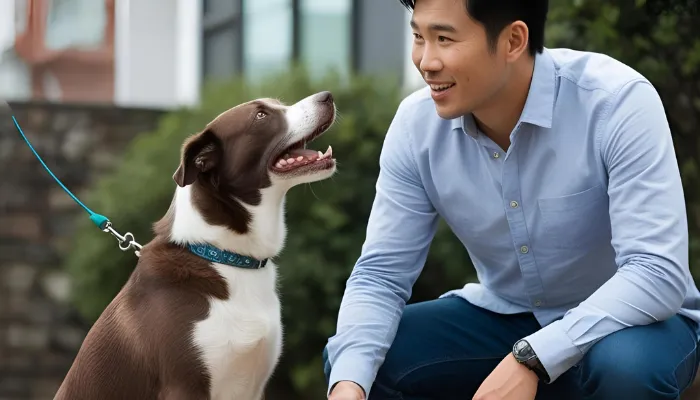How Do You Tell a Dog You’re Sorry? Dogs may not grasp language the way we do, but they understand tones, body movements and actions. If you have angered your canine companion, there are ways to repair the relationship. Apologizing to a dog requires a lot of patience and love and most importantly, understanding . With the right method, like the dog translator app, you can express yourself fully. Let us look into how you can earn your dog’s trust once again and assure them of your affection.

Do Dogs Understand Apologies?
Dogs don’t understand apologies like humans—they rely on emotions, not words. Facial expressions, tone, and actions play a key role in rebuilding trust.
- Apologies are incomprehensible gestures for dogs – They depend on feelings rather than language.
- Soft voice and gentle body language are important – Gentle voices and body language communicate remorse to dogs.
- Affectionable actions restore trust – The relationship can be healed with love, gifts, and games.
- Smoothing body movements accomplish greater effects – Using a relaxed position and not making jerky movements aids.
- Trust is developed through kindness in nurturing actions over a period of time – To build greater trust, a person should repeatedly carry out kind actions.
Kindness and patience help dogs forgive, but how do you tell a dog you’re sorry? Soft speech, gentle touch, and loving gestures make all the difference.
10 Ways to Apologize to Your Dog and Rebuild Trust
If you have unintentionally scared or hurt your dog, here are some effective ways to make amends:
1. Speak In a Soft And Calm Tone
- Speak in a soft tone and guide your dog’s attention towards yourself.
- Do not raise your voice as that will come off as hostile or uncivil.
- Put in phrasing like, “good boy”, or, “it’s alright.”
2. Use Positive Body Language
- Sit down to their level.
- Do not stare directly if there is a sense of anxiety.
- Extend your hands in front of you to show you mean no harm.
3. Offer Their Favorite Treats
- A treat is one way of showing love and comfort.
- Make sure the treat is safe and nutritious.
- Give them the treat if they have a positive reaction.
4. Pet Them the Way They Like
- Gently stroke their favorite spot (ears, belly, or back).
- If they back away, give them space before trying again.
5. Play Their Favorite Game
- Fetch and tug of war are some examples of enjoyable activities.
- If they are shy, allow them to start the game if they want.
6. Give Them Time to Adjust
- Certain dogs need a little alone time to gather themselves emotionally.
- Allow them their personal space and wait for them to seek you out.
7. Show Consistency and Love
- Regular affection and positive reinforcement build trust.
- Avoid repeating the action that upset them.
8. Offer a Comforting Environment
- Let them have their toy or blanket.
- Less loud sounds, and distractions, need to be on the minimum side.
9. Take a Walk Together
- Walking together strengthens the bond.
- Let them explore and enjoy fresh air freely.
10. Use a Dog Translator App (Optional)
- Some apps claim to interpret dog sounds.
- They are not completely reliable, but they could help to some extent in reading your dog’s emotions.
Making amends with your dog takes patience, love, and understanding. Small gestures like soft words, treats, and play help rebuild trust. How do you tell a dog you’re sorry? Show kindness consistently, and your bond will grow stronger.
How Long Does It Take for a Dog to Forgive?
The time a dog takes to forgive depends on:
| Factor | Timeframe |
|---|---|
| Minor mistake | A few minutes |
| Ignored commands | A few hours |
| Unintentional hurt | A day or two |
| Repeated mistakes | Weeks (with trust rebuilding) |
Patience is key. Some dogs forgive quickly, while others take time.
Forgiveness varies based on the situation and your dog’s temperament. Patience, love, and reassurance help speed up the process. How do you tell a dog you’re sorry? Gentle words, positive actions, and consistency rebuild trust.
Signs That Your Dog Has Forgiven You
How do you tell a dog you’re sorry and know they accept it? Look for these signs:
- Tail wagging – Shows they are happy again.
- Licking you – Indicates affection and forgiveness.
- Relaxed body language – No more stiff posture or hiding.
- Approaching you – They feel safe around you.
- Carrying their toys – Another sign to indicate that they are trusting you and ready to play.
A dog that is forgiving shows its love through playful acts, tail wags, and snuggles. However, trust is built over time and care. But what about dogs who are supposed to be very caring? Apologies stems from gentle movements and a holistic approach towards the dog helps mend fences.
What to Avoid When Apologizing?
Dogs respond best to gentle and caring behavior and hence, to their care, an apology should involve patience and consideration. Avoiding common mistakes helps rebuild trust and strengthen your bond.
Shouting
Yelling at your dog can cause them to be afraid and escalate the issue even more.
Forcing Physical Contact
If they back away, give them time before trying to pet them.
Not Acknowledging Their Feelings
If your dog behaves in another demeanor, you should normalize the condition with some validation.
Making amends means respecting your dog’s feelings as well which sometimes means leaving them alone for a bit. But how does one go about saying I’m sorry to a dog? Gentle actions that harness a softer side coupled with a patient demeanor demonstrates real remorse.
Conclusion
How Do You Tell a Dog You’re Sorry? The answer is care, calmness, and comprehension. Dogs are trained with sweet words, delicate strokes, and good actions. So, just give your dog some time, food, and play with them in order to reestablish trust. Whether you choose to do it through signals or a Dog Speaker, whatever the method, you must remember, it has to be sincere to resolve the issue with your pet.
